Why Don't we Bleed out to Death after we get a Cut or a Bleeding Injury!
As kids we've all cut ourselves, injured ourselves falling off from bicycles or maybe that sliding tackle on your opponent to prevent that precious goal! One way or other, we've seen blood coming out!
But did you ever wonder, once the blood starts coming out, why don't we eventually completely bleed out to death? How is it that after a while the bleeding stops?

Let's find out, shall we!
Initial Response to Vessel Injury
Whenever there is injury to a blood vessel, the protective covering (aka, endothelium) is damaged and stuff that were once hidden beneath/protected by the endothelium now gets exposed.
One such molecule that gets exposed is called von Willebrand Factor, vWF. We know we have platelets floating around in the blood, right? (Platelets are a type of blood cell, tiny in size).
These platelets have receptors (GpIb) that can bind to vWF.
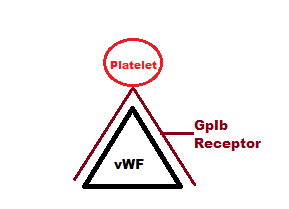
Image Illustration done by @simplifylife
After this happens, this is a signal for platelets to release two substances : ADP and Thromboxane A2, TXA2.
- TXA2 is a vasoconstrictor. It constricts the injured vessel, thus reducing blood flow through that injured place. Kind of like when there's a leakage in water pipes, we try to squeeze the pipe to reduce leakage of water flow. Smart!
- What ADP does is a bit more interesting. We have a lot of things floating in our blood, just floating around, doing nothing, waiting for the right command! One such molecule is Fibrinogen. There's a receptor called GpIIb-IIIa on fibrinogen and ADP changes it's shape in such a way that now it can bind to platelets!
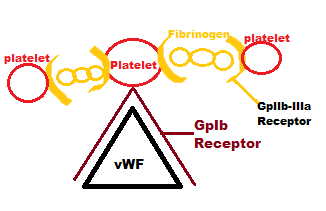
Image Illustration done by @simplifylife
As you can see from the image above, fibrinogen with it's activated receptor now binds to multiple platelets. What this does is brings and binds together a lot of platelets. This process is known as Platelet Aggregation.
Numerous platelets come together and aggregate and bound together by fibrinogen. This collection on platelets and fibrinogen forms a temporary plug which initially seals the leak and stops the bleeding. What this does is give the body time to produce a stronger, more stable clot.
Forming a Stronger and More Stable Clot
Remember earlier, damage to the endothelium exposes a lot of stuff which were hidden. Another molecule that gets exposed is subendothelial collagen. This activates another floating substance in the blood, Factor XII, aka the Hageman Factor.
The damaged tissue also release a substance called _Tissue Thromboplastin._ This activates another factor, Factor VII.
Okay I know this is getting too complicated with all these numbers, so i'll skip a few numbers and jump straight to the important one. Both of these activated factors, after a series of steps eventually activates Factor X.
Factor X forms part of a complex structure called the Prothrombin Complex, and as everything else we have seen so far, it activates something else too! Kill me now LOL!
Prothrombin complex activates prothtombin into Thrombin.
Converting Unstable Plug into a Stable Clot
Remember the fibrinogen molecules holding the platelet aggregates. That fibrinogen is a soluble molecule and this is sort of why that plug is unstable. If the fibrinogen dissolves, there's nothing to hold the platelets together and they'll wander away, causing the injury to re-bleed.
In comes Thrombin.
Thrombin converts fibrinogen into fibrin monomers. Fibrin monomers are still soluble.
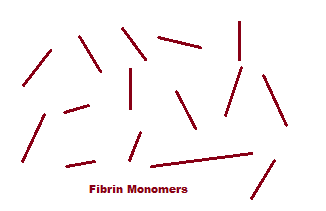
Image Illustration done by @simplifylife
So Thrombin does one final act! It activates yet another factor! Kill me now! Please kill me now!
Thrombin activates Factor XIII and activated factor XIII add the final touch to this mess! It cross links many many fibrin monomers together and this cross-linked fibrin now forms a complex that is now insoluble. Cross linking makes it insoluble because instead of many different fibrin monomers, this is now virtually one single, large complex molecule.
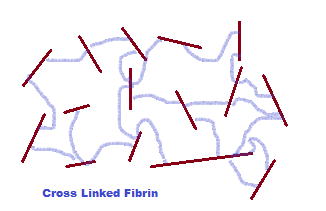
Image Illustration done by @simplifylife
After this stable clot has stopped the bleeding, the injured vessel has enough time to slowly heal itself, regenerate the damaged endothelium and once the need of the clot is over, the clot will be dissolved by the body's intrinsic fibrinolytic pathway. As you can imagine from the name, the cross links are broken down, making the fibrin soluble and it dissolves away.
And that, ladies and gentlemen, is how you do not bleed to death after every single minor cuts! Be thankful for this amazing human body we have!
References :
Goljan Rapid Review Pathology, 4th ed
Guyton and Hall, Textbook of Medical Physiology, 13th ed
How Blood Clots

If you enjoy medical topics, or want to learn how different things work in this amazing human body, please make sure to follow me at @simplifylife
Join the Steemstem Discord if you want to start writing high quality science articles as well!!
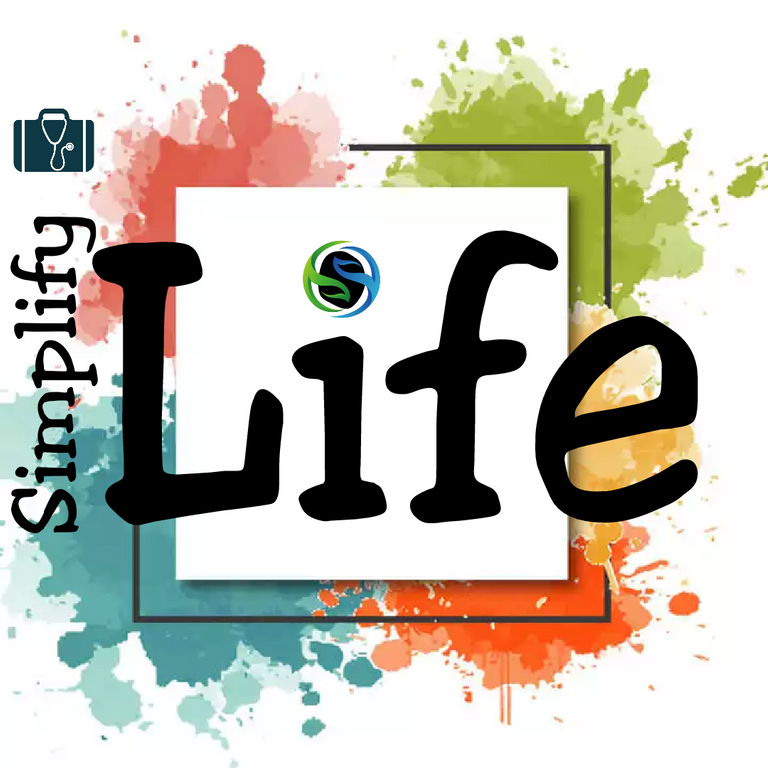
If you like Simplistic Logos To Use at the end of your posts and want one for yourself, let me know in the comments or shoot me a DM on discord (simplifylife#8338)
Until Next Time!
Peace!
You post has been manually curated by BDvoter Team! To know more about us please visit our website or join our Discord.
Are you a Splinterlands player? If Yes, then checkout MonsterMarket.io. Get instant 3% cashback on every card purchase, and 2% cashback on every booster pack purchase on MonsterMarket.io. MonsterMarket has the highest revenue sharing in the space - 60% for cards and 40% for packs, no minimum spending is required. Join MonsterMarket Discord.
BDvoter Team
You are a very good writer, Keep it up brother, Best wishes for future life...
Thank you for the compliment 🙂
Hi @simplifylife, your post has been upvoted by @bdcommunity courtesy of @ayashabd!
Support us by setting us as your witness proxy or delegating STEEM POWER.
JOIN US ON
Hey there buddy, thanks. This was insightful.
Thank you :)
Another thing that really helps in blood clotting is the presence of Vitamin K in one's body. Vitamin K aids in blood coagulation, without it, uncontrolled bleeding occurs.
Hence, we need to feed with meals that contains V-K
Vitamin k is not directly involved in the coagulation cascade.
What vit-k does is it carboxylates factors II, VII, IX and X. Without this, they are non functional.
Thanks for stopping by 😃
Glad you said, ...directly involved but it plays a role
Yes definitely plays a role. It is in fact supplemented in some forms of bleeding.
Thanks for the clarification
Wow! It's crazy that something as seemingly simple as a scab has so much complexity behind it. Very interesting!
The human body does wonders behind the scenes!
This post has been voted on by the SteemSTEM curation team and voting trail. It is elligible for support from @curie and @minnowbooster.
If you appreciate the work we are doing, then consider supporting our witness @stem.witness. Additional witness support to the curie witness would be appreciated as well.
For additional information please join us on the SteemSTEM discord and to get to know the rest of the community!
Please consider using the steemstem.io app and/or including @steemstem in the list of beneficiaries of this post. This could yield a stronger support from SteemSTEM.